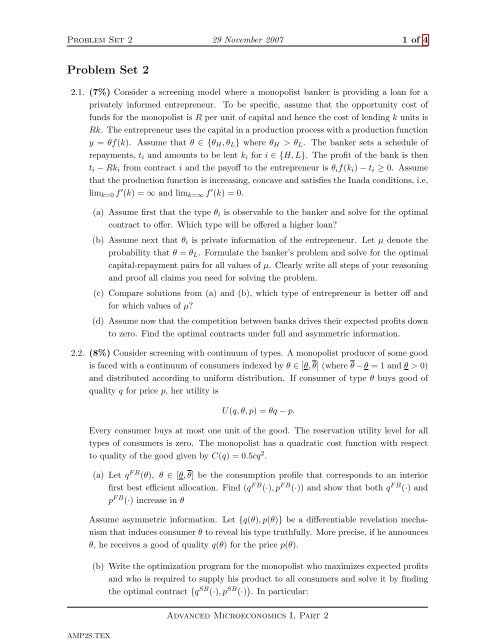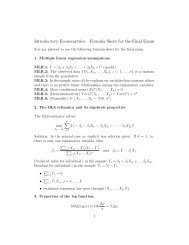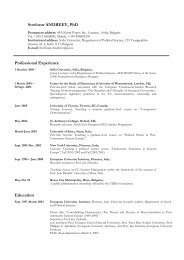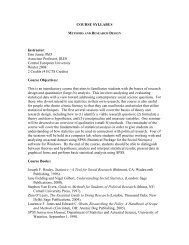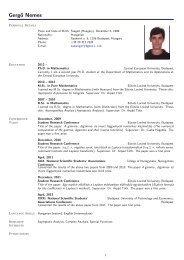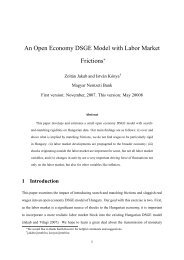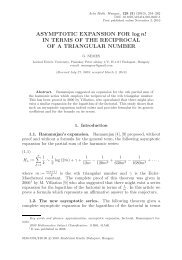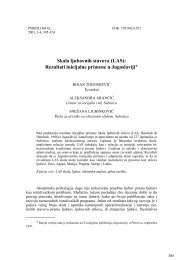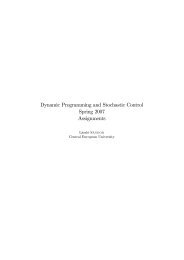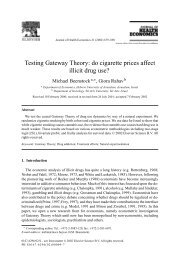Problem Set 2 - Personal pages of the CEU
Problem Set 2 - Personal pages of the CEU
Problem Set 2 - Personal pages of the CEU
You also want an ePaper? Increase the reach of your titles
YUMPU automatically turns print PDFs into web optimized ePapers that Google loves.
AMP2S.TEX<br />
<strong>Problem</strong> <strong>Set</strong> 2 29 November 2007 1 <strong>of</strong> 4<br />
<strong>Problem</strong> <strong>Set</strong> 2<br />
2.1. (7%) Consider a screening model where a monopolist banker is providing a loan for a<br />
privately informed entrepreneur. To be specific, assume that <strong>the</strong> opportunity cost <strong>of</strong><br />
funds for <strong>the</strong> monopolist is R per unit <strong>of</strong> capital and hence <strong>the</strong> cost <strong>of</strong> lending k units is<br />
Rk. The entrepreneur uses <strong>the</strong> capital in a production process with a production function<br />
y = θf(k). Assume that θ ∈ {θ H , θ L } where θ H > θ L . The banker sets a schedule <strong>of</strong><br />
repayments, t i and amounts to be lent k i for i ∈ {H, L}. The pr<strong>of</strong>it <strong>of</strong> <strong>the</strong> bank is <strong>the</strong>n<br />
t i − Rk i from contract i and <strong>the</strong> pay<strong>of</strong>f to <strong>the</strong> entrepreneur is θ i f(k i ) − t i ≥ 0. Assume<br />
that <strong>the</strong> production function is increasing, concave and satisfies <strong>the</strong> Inada conditions, i.e,<br />
lim k=0 f ′ (k) = ∞ and lim k=∞ f ′ (k) = 0.<br />
(a) Assume first that <strong>the</strong> type θ i is observable to <strong>the</strong> banker and solve for <strong>the</strong> optimal<br />
contract to <strong>of</strong>fer. Which type will be <strong>of</strong>fered a higher loan?<br />
(b) Assume next that θ i is private information <strong>of</strong> <strong>the</strong> entrepreneur. Let µ denote <strong>the</strong><br />
probability that θ = θ L . Formulate <strong>the</strong> banker’s problem and solve for <strong>the</strong> optimal<br />
capital-repayment pairs for all values <strong>of</strong> µ. Clearly write all steps <strong>of</strong> your reasoning<br />
and pro<strong>of</strong> all claims you need for solving <strong>the</strong> problem.<br />
(c) Compare solutions from (a) and (b), which type <strong>of</strong> entrepreneur is better <strong>of</strong>f and<br />
for which values <strong>of</strong> µ?<br />
(d) Assume now that <strong>the</strong> competition between banks drives <strong>the</strong>ir expected pr<strong>of</strong>its down<br />
to zero. Find <strong>the</strong> optimal contracts under full and asymmetric information.<br />
2.2. (8%) Consider screening with continuum <strong>of</strong> types. A monopolist producer <strong>of</strong> some good<br />
is faced with a continuum <strong>of</strong> consumers indexed by θ ∈ [θ, θ] (where θ − θ = 1 and θ > 0)<br />
and distributed according to uniform distribution. If consumer <strong>of</strong> type θ buys good <strong>of</strong><br />
quality q for price p, her utility is<br />
U(q, θ, p) = θq − p.<br />
Every consumer buys at most one unit <strong>of</strong> <strong>the</strong> good. The reservation utility level for all<br />
types <strong>of</strong> consumers is zero. The monopolist has a quadratic cost function with respect<br />
to quality <strong>of</strong> <strong>the</strong> good given by C(q) = 0.5cq 2 .<br />
(a) Let q F B (θ), θ ∈ [θ, θ] be <strong>the</strong> consumption pr<strong>of</strong>ile that corresponds to an interior<br />
first best efficient allocation. Find (q F B (·), p F B (·)) and show that both q F B (·) and<br />
p F B (·) increase in θ<br />
Assume asymmetric information. Let {q(θ), p(θ)} be a differentiable revelation mechanism<br />
that induces consumer θ to reveal his type truthfully. More precise, if he announces<br />
θ, he receives a good <strong>of</strong> quality q(θ) for <strong>the</strong> price p(θ).<br />
(b) Write <strong>the</strong> optimization program for <strong>the</strong> monopolist who maximizes expected pr<strong>of</strong>its<br />
and who is required to supply his product to all consumers and solve it by finding<br />
<strong>the</strong> optimal contract ( q SB (·), p SB (·) ) . In particular:<br />
Advanced Microeconomics I, Part 2
AMP2S.TEX<br />
<strong>Problem</strong> <strong>Set</strong> 2 29 November 2007 2 <strong>of</strong> 4<br />
(i) Write down IC constraint and show, by deriving FOC and SOCs, that it is<br />
equivalent to LIC and monotonicity <strong>of</strong> q(·).<br />
(ii) Write down P constraint and show that it has to be binding for <strong>the</strong> lowest type<br />
and it is irrelevant for any higher type.<br />
(iii) Derive <strong>the</strong> formula for p(·) from LIC and put it into <strong>the</strong> objective function <strong>of</strong><br />
<strong>the</strong> monopolist.<br />
(iv) Find optimal q(·) by ignoring monotonicity constraint.<br />
(c) For <strong>the</strong> optimal contract ( q SB (·), p SB (·) )<br />
(i) Check if <strong>the</strong> optimal pr<strong>of</strong>ile q SB (·) is increasing in θ.<br />
(ii) Check if information rent is increasing with θ<br />
(iii) Check if ‘no distortion at <strong>the</strong> top’ rule is preserved at <strong>the</strong> optimum.<br />
2.3. (5%) Consider <strong>the</strong> moral hazard model with two outcomes and two effort levels discussed<br />
during <strong>the</strong> lecture and do one modification: <strong>the</strong> Agent is risk neutral. All o<strong>the</strong>r<br />
assumptions are preserved.<br />
(a) Characterize all optimal contracts for <strong>the</strong> P if he wants <strong>the</strong> A to choose high effort<br />
level.<br />
Assume additionally that high effort level produces more social surplus than <strong>the</strong> low<br />
effort level.<br />
(b) Show that it is <strong>the</strong> best for <strong>the</strong> P if <strong>the</strong> A chooses high effort level.<br />
(c) Show that <strong>the</strong>re exists <strong>the</strong> optimal contract which involves <strong>the</strong> P getting a fixed<br />
rent from <strong>the</strong> A, who becomes <strong>the</strong>n a residual claimant, bearing all <strong>the</strong> risk and<br />
taking all <strong>the</strong> pr<strong>of</strong>its and losses.<br />
2.4. (7%) Consider a principal-agent problem with three exogenous states <strong>of</strong> nature, θ 1 , θ 2 ,<br />
and θ 3 ; two effort levels, e L and e H ; and two output levels, distributed as follows as a<br />
function <strong>of</strong> <strong>the</strong> state <strong>of</strong> nature and <strong>the</strong> effort level:<br />
State <strong>of</strong> nature θ 1 θ 2 θ 3<br />
Probability 0.25 0.5 0.25<br />
Output under e H 18 18 1<br />
Output under e L 18 1 1<br />
The state <strong>of</strong> nature is not verifiable (it cannot be contracted on). The principal is risk<br />
neutral. The agent’s utility when choosing effort e and receiving monetary compensation<br />
w is √ w − g(e), where g(e L ) = 0 and g(e H ) = 0.1. The agent’s reservation utility is 0.1.<br />
(a) Derive <strong>the</strong> optimal contract assuming that <strong>the</strong> agent’s action is (observable and)<br />
verifiable.<br />
(b) Derive <strong>the</strong> optimal contract assuming that <strong>the</strong> agent’s action is not verifiable.<br />
Advanced Microeconomics I, Part 2
AMP2S.TEX<br />
<strong>Problem</strong> <strong>Set</strong> 2 29 November 2007 3 <strong>of</strong> 4<br />
(c) Assume <strong>the</strong> principal can buy, for a price <strong>of</strong> 0.1, an information system that allows<br />
<strong>the</strong> parties to verify whe<strong>the</strong>r or not state <strong>of</strong> nature θ 3 happened. Will <strong>the</strong> principal<br />
buy this information system?<br />
2.5. (3%) During <strong>the</strong> lecture we showed that in moral hazard model with two effort levels<br />
and continuum <strong>of</strong> outcomes if both parties are risk neutral, selling <strong>the</strong> project to <strong>the</strong> A<br />
(making him residual claimant) is optimal for <strong>the</strong> P. Show that such a contract is also<br />
optimal when <strong>the</strong> A is risk neutral and <strong>the</strong> P is risk-averse.<br />
2.6. (5%) Consider <strong>the</strong> following variant <strong>of</strong> Clarke-Groves mechanism discussed in <strong>the</strong> class:<br />
• Every agent reports a valuation ˆθ i .<br />
• The bridge is built if and only ∑ I<br />
i=1 ˆθ i ≥ 0.<br />
• Each agent receives a payment equal to <strong>the</strong> sum <strong>of</strong> o<strong>the</strong>r bids if <strong>the</strong> bridge is built,<br />
i.e, T i = − ∑ j≠i ˆθ j . Hence, if ∑ j≠i ˆθ j > 0 agent i receives payment; o<strong>the</strong>rwise she<br />
has to pay.<br />
• If bridge is not built <strong>the</strong>n all T i = 0.<br />
(a) Show that <strong>the</strong> truth telling is a dominant strategy for every agent, hence <strong>the</strong> mechanism<br />
leads to efficient outcome.<br />
(b) Is this mechanism balanced?<br />
Since <strong>the</strong> above mechanism is not balanced, to improve it we may to introduce “tax”<br />
on agents to assure balanced budget. The basic idea is to require each agent i to make<br />
an additional payment that depends only on what <strong>the</strong> o<strong>the</strong>r agents do without affecting<br />
any <strong>of</strong> i’s incentives. Let ˆθ −i be a I − 1-dimensional vector <strong>of</strong> reports omitting <strong>the</strong><br />
report <strong>of</strong> agent i and let h i (ˆθ −i ) be an extra payment made by <strong>the</strong> agent i always, i.e.,<br />
independently if <strong>the</strong> bridge is built or not. Hence, we have, compared to <strong>the</strong> previous<br />
problem: T i = − ∑ ˆθ j≠i j + h i (ˆθ −i ) if bridge is built; T i = h i (ˆθ −i ) if bridge is not built.<br />
(c) Show that <strong>the</strong> truth telling is again a dominant strategy for every agent.<br />
(d) Assume that h i (ˆθ −i ) = ∑ j≠i ˆθ j if ∑ j≠i ˆθ j ≥ 0 and h i (ˆθ −i ) = 0 if ∑ j≠i ˆθ j < 0. Show<br />
that under this scheme every agent may be taxed but never subsidized. Is this new<br />
scheme balanced?<br />
2.7. (3%) Show that in <strong>the</strong> model <strong>of</strong> ‘cheap talk’ game analyzed during <strong>the</strong> lecture, <strong>the</strong><br />
equilibrium with two different messages is better for both sender and receiver than <strong>the</strong><br />
‘babbling’ equilibrium.<br />
2.8. (6%) Consider a variant <strong>of</strong> <strong>the</strong> cheap talk game analyzed in <strong>the</strong> class in which pay<strong>of</strong>f<br />
functions are: for Receiver −|y − t|; for Sender −|y − (t + b)|. Find <strong>the</strong> 2-report and<br />
3-report Perfect Bayesian Equilibrium for this game. How <strong>the</strong>y differ from analogous<br />
equilibria from <strong>the</strong> original model?<br />
Advanced Microeconomics I, Part 2
AMP2S.TEX<br />
<strong>Problem</strong> <strong>Set</strong> 2 29 November 2007 4 <strong>of</strong> 4<br />
2.9. (4%) Consider a variant <strong>of</strong> cheap talk model discussed in <strong>the</strong> class when decision maker<br />
consults two experts who observe t but have different positive biases: b 1 , b 2 > 0, b 1 ≠ b 2 .<br />
Both experts report to <strong>the</strong> decision maker simultaneously and <strong>the</strong>n <strong>the</strong> decision maker<br />
chooses <strong>the</strong> action that is <strong>the</strong> more ’conservative’ <strong>of</strong> <strong>the</strong> two reports. Precisely, if m 1 < m 2<br />
he chooses action m 1 and vice versa if m 2 < m 1 .<br />
(a) Model <strong>the</strong> expert’s game as a static game with complete information, what are<br />
strategy spaces and pay<strong>of</strong>f functions?<br />
(b) Consider <strong>the</strong> following pair <strong>of</strong> strategies m 1 (t) = m 2 (t) = t + k where k ≥ 0. Find<br />
all values <strong>of</strong> k for which <strong>the</strong> above pair is a Nash equilibrium <strong>of</strong> <strong>the</strong> expert game.<br />
(c) What is <strong>the</strong> Pareto ranking <strong>of</strong> <strong>the</strong> Nash equilibria from (b); which equilibrium is<br />
<strong>the</strong> best from expert’s point <strong>of</strong> view?<br />
2.10. (10%) Consider <strong>the</strong> communication game analyzed in <strong>the</strong> class, with full commitment<br />
contract proposed by <strong>the</strong> decision maker. Hence, he proposes <strong>the</strong> compensation scheme<br />
x(ˆt) ≥ 0 to <strong>the</strong> expert, based on <strong>the</strong> expert report ˆt, moreover, he commits ex-ante to <strong>the</strong><br />
choice y(ˆt) based on <strong>the</strong> expert report. If <strong>the</strong> expert does not accept <strong>the</strong> report, <strong>the</strong>re is<br />
no communication.<br />
(a) Model this mechanism as an example <strong>of</strong> screening with continuum <strong>of</strong> types. Who<br />
is <strong>the</strong> Principal and who is <strong>the</strong> Agent? Is Single Crossing Property fulfilled in this<br />
model?<br />
(b) Solve for optimal contract assuming for simplicity that <strong>the</strong> reservation utility <strong>of</strong> <strong>the</strong><br />
A is zero. You may use all results and methods derived in <strong>the</strong> class. If you have<br />
problems, you may solve for special values <strong>of</strong> b, say b = 1/4, b = 0.5.<br />
(c) Show that although truthful reporting by <strong>the</strong> A is preserved (due to <strong>the</strong> Revelation<br />
Principle and incentive compatibility), <strong>the</strong> Principal never implements y(t) = t.<br />
Advanced Microeconomics I, Part 2


